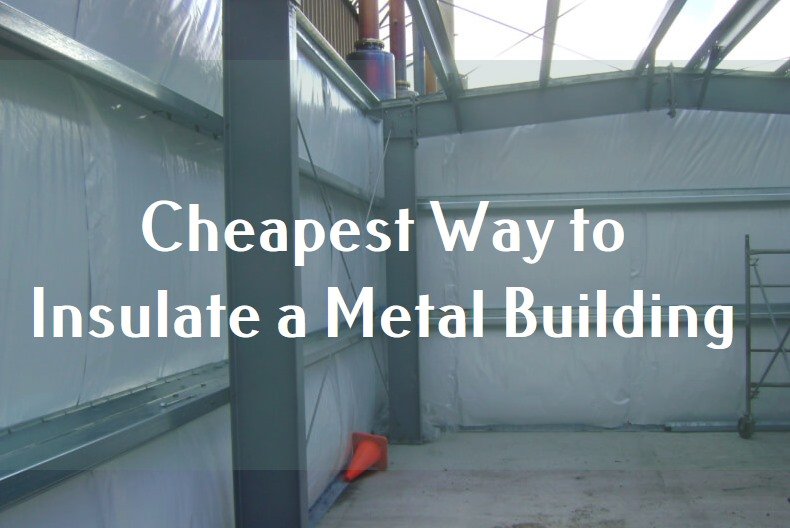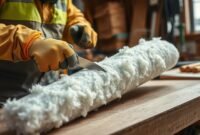Metal buildings are strong, but they have trouble with temperature. Owners often see high energy bills and uncomfortable spaces. Without insulation, steel buildings get too cold in winter and too hot in summer.
Finding the cheapest insulation for metal buildings is key. It’s not just about saving money. It’s about making your space comfortable and energy-efficient. I’ll share affordable ways to stop condensation and make your metal building a smart investment.

Understanding Metal Building Insulation Basics
Metal building insulation is key for a cozy and energy-saving space. I’ve seen how good insulation changes a metal building’s feel and function. It’s a game-changer.
What is Metal Building Insulation?
Metal building insulation is a special layer to stop heat transfer. It keeps the temperature and moisture right in a metal building. Knowing how to attach foam board to concrete wall is important. It helps prevent heat loss in cold months and heat gain in hot months.
Benefits of Proper Insulation
Good insulation does more than just control temperature. Here are the main benefits:
- Big savings on energy costs
- Better comfort inside
- Less condensation
- Better sound absorption
- Protection from moisture damage
Key Insulation Measurements
Choosing the right insulation means knowing key measurements. When picking glue for foam board, look at these ratings:
- R-value: Shows how well insulation keeps heat out
- U-value: Tells you how much heat is transferred
- Perm rating: Shows how well insulation lets moisture pass through
These measurements are essential for your insulation to work well. The right mix keeps your metal building comfy and energy-smart all year.
Critical Factors Affecting Metal Building Insulation
Insulating a metal building requires careful thought. It’s not just about picking a material. You need to understand your specific needs and environment.
The climate is key in choosing insulation. In areas with extreme temperatures, you need insulation that can handle big temperature changes. Always check your local weather before deciding.
- Building purpose impacts insulation requirements
- Structural characteristics influence material selection
- Budget constraints shape possible solutions
Choosing the right adhesive for foam board on concrete is critical. The best adhesive depends on the surface, temperature, and use. Polyurethane-based adhesives are often strong enough for metal buildings.
Read also: Insulate Garage Ceiling With Foam Board
Energy efficiency is very important. Good insulation can cut down on heating and cooling costs. Always think about long-term savings when picking insulation.
- Moisture resistance
- Fire safety ratings
- Environmental impact
- Installation complexity
By looking at these factors, you can create a solid insulation plan. It will meet your metal building’s needs while keeping costs down and performance high.
Read also: How to Insulate a Shed Floor
Temperature Control and Energy Efficiency Benefits
Insulating a metal building does more than just block temperature changes. It turns your space into a place that saves energy. Many property owners have cut their energy costs a lot by using smart insulation.
Heat Transfer Prevention
Metal buildings let heat pass through easily, making it hard to control the temperature. Good insulation acts as a shield, stopping heat from moving in and out. Knowing how much foam board adhesive you need is key for a good install.
Cost Savings on Energy Bills
Smart insulation can save you a lot of money. Here are some ways you can save:
- Less money spent on heating and cooling
- Less energy wasted
- Longer life for your HVAC system
- Lower bills every month
When picking materials, find the best adhesive for foam board to wood. This ensures a strong, lasting install that saves energy.
Year-round Comfort Solutions
Good insulation keeps your space comfortable all year. It stops heat from moving and keeps the temperature stable. My clients say they feel more comfortable and use less energy after getting their spaces well-insulated.
Common Types of Metal Building Insulation Materials
Choosing the right insulation for a metal building is key. It affects both performance and cost. I’ve seen many insulation types that stop condensation and keep the building warm.

- Fiberglass Insulation: The budget-friendly champion
- Available in batts, rolls, and loose-fill
- Easy to install when learning how to attach a board to concrete
- Cost-effective for large metal buildings
- Spray Foam Insulation: High-performance option
- Excellent at preventing condensation
- Provides superior air sealing
- Higher initial cost but better long-term efficiency
- Reflective Foil Insulation: Heat barrier solution
- Reflects radiant heat
- Lightweight and easy to install
- Works well in hot climates
- Rigid Board Insulation: Structural support
- Solid panels with high R-value
- Great for walls and roofs
- Helps prevent moisture buildup
Before choosing insulation, think about your building’s needs, the climate, and your budget. Each insulation type has its own strengths. Knowing these can help you pick the best one for your metal building.
Cheapest Way to Insulate a Metal Building
Insulating a metal building can be done on a budget. I’ve helped many clients find affordable ways to keep their buildings warm and energy-efficient. This doesn’t mean you have to sacrifice quality.
Insulating a metal building on a budget means choosing the right materials and installing them wisely. Let’s look at the best ways to make your metal building cozy and save on energy costs.
Cost-Effective Material Options
There are several affordable insulation materials for metal buildings:
- Fiberglass batt insulation: Most affordable option
- Reflective foil insulation: Lightweight and inexpensive
- Loose-fill insulation: Great for hard-to-reach areas
DIY Installation Tips
Learning to attach foam board to concrete walls can save you money. Here are some tips:
- Clean the concrete surface thoroughly
- Use appropriate adhesive or mechanical fasteners
- Ensure proper vapor barrier installation
- Seal all edges to prevent air infiltration
Budget-Friendly Solutions
To save money, try these strategies:
| Strategy | Potential Savings |
|---|---|
| Combine insulation types | Up to 30% cost reduction |
| DIY installation | Save 50-70% on labor costs |
| Bulk material purchasing | 10-20% additional savings |
By using these cost-saving methods, you can insulate your metal building without spending too much. Always focus on proper installation and choosing the right materials for long-term energy savings and comfort.
Moisture Control and Condensation Prevention
Keeping moisture out of metal buildings is key to their health. Warm, moist air meeting cold surfaces can cause big problems. I’ve seen many metal buildings damaged by unchecked humidity, leading to energy loss.
To stop condensation, I suggest a few important steps:
- Install a high-quality vapor barrier to block moisture transmission
- Ensure proper ventilation throughout the building
- Use appropriate insulation materials that resist moisture buildup
When using foam board insulation, picking the right glue is essential. I advise using foam board adhesives that stop moisture. These adhesives seal air gaps and protect against condensation.
Choosing the best moisture control method depends on several things:
- Local climate conditions
- Building usage
- Existing ventilation systems
- Budget constraints
A good moisture control plan can save you a lot of money. By understanding condensation and taking steps to prevent it, you’ll keep your metal building strong and energy-efficient for years.
Professional Installation vs DIY Approaches
Deciding between professional installation and DIY for metal building insulation is tough. It affects your budget and project quality.
Cost Comparison
DIY installation can save money at first. When you attach foam board to concrete, the cost difference is big. Professionals charge 2-3 times more than DIY.
- Professional installation: $2-$5 per square foot
- DIY installation: $0.50-$1.50 per square foot
- Potential additional savings on materials
Time and Effort Considerations
DIY projects take a lot of time. Finding the right adhesive for foam board is key. Professionals work faster and save you effort, which is great if you’re busy.
- Assess your available time
- Evaluate personal skill level
- Consider complexity of insulation method
Quality and Performance Factors
Professionals know how to do it right, which improves insulation. They focus on sealing and preventing moisture, which DIY folks might miss.
Your choice depends on your budget, time, and confidence in DIY skills. Think carefully about the pros and cons before deciding.
Maintenance and Long-term Performance

Keeping your metal building’s insulation in good shape is key for lasting energy savings. Knowing how much foam board adhesive you need is important. The right amount can make your insulation last longer.
Regular checks are essential to keep your insulation working well. Watch out for these signs of trouble:
- Visible gaps or tears in insulation material
- Moisture accumulation or water stains
- Compressed or sagging insulation sections
- Unusual temperature fluctuations inside the building
Choosing the right adhesive for foam board to wood is critical. Use high-quality polyurethane-based adhesives. They offer strong bonds and can handle temperature changes.
Here are some tips to keep your insulation at its best:
- Do detailed inspections every six months
- Seal any gaps you find right away
- Look out for pests
- Make sure there’s good air flow
Regular maintenance helps your insulation last longer and saves energy. A little effort now can save a lot of money later.
Building Code Compliance and Safety Considerations
Understanding building codes and safety rules is key when insulating a metal building. I’ve learned that skipping these steps can cause big problems and safety risks.
Insulation is more than just keeping things cozy. It’s about following important safety and legal standards. These protect your investment and everyone who uses the building.
Fire Safety Requirements
When picking insulation, fire safety is a big deal. Not all insulation can handle fire well. I suggest choosing materials that are known to be fire-resistant to lower risks.
- Check fire ratings for all insulation materials
- Verify flame spread and smoke development ratings
- Select materials that meet local fire safety codes
Local Building Regulations
Knowing local building rules is essential for safe and legal installation. Each area has its own rules for attaching boards to concrete. These rules help avoid moisture problems and keep the structure strong.
Energy Code Standards
Energy efficiency is not just about saving money. It’s also about following strict energy codes. I recommend working with a pro who knows these rules. They can help pick the right insulation for your needs.
- Verify R-value requirements for your region
- Consider climate-specific insulation recommendations
- Ensure compliance with local energy conservation codes
By focusing on building code compliance and safety, you’ll build a safe, efficient, and legal metal building. It will last for years to come.
Conclusion
Insulating a metal building doesn’t have to be expensive. I’ve looked into many ways to keep costs low while ensuring good performance. The main idea is that smart insulation is a smart investment, not just a cost.
When picking insulation, think about what your building needs. Stopping moisture is key to keeping your building strong. The right materials and methods can make your space comfy, save energy, and handle tough weather.
It’s wise to weigh upfront costs against long-term gains. While there are affordable options, they must fit your needs. Good insulation keeps your building safe, cuts energy bills, and makes it more comfortable. With smart planning, you can get great results without spending too much.
Every metal building is different. What works for one might not be best for another. Take your time to figure out what your building needs, the local weather, and how you’ll use it. Your careful choice will lead to better comfort, energy savings, and a longer-lasting building.


